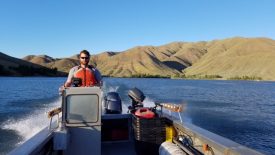 Kokanee (Oncorhynchus nerka) is a common freshwater fish found throughout much of the world. Kokanee support valued recreational fisheries and are a food source for economically, socially, and ecologically important fishes (e.g., bull trout (Salvelinus confluentus) and rainbow trout (O. mykiss)). Despite their importance, many knowledge gaps remain regarding kokanee ecology and management. For instance, kokanee populations are commonly managed using data collected from mid-water trawls. Biases of mid-water trawls have not been quantified, leading to uncertainty in estimates obtained from these data (e.g., age composition, length distribution). In addition, relatively little is known about the recruitment dynamics of kokanee. Kokanee have experienced significant declines throughout much of their distribution, but the mechanisms underlying kokanee declines are poorly understood. Therefore, the goals of my proposed research are to 1) evaluate biases of mid-water trawls, 2) investigate interspecific competition between opossum shrimp and kokanee as it relates to recruitment variability, and 3) evaluate the growth and overwinter survival of early-run vs. late-run kokanee breeding groups.
Kokanee (Oncorhynchus nerka) is a common freshwater fish found throughout much of the world. Kokanee support valued recreational fisheries and are a food source for economically, socially, and ecologically important fishes (e.g., bull trout (Salvelinus confluentus) and rainbow trout (O. mykiss)). Despite their importance, many knowledge gaps remain regarding kokanee ecology and management. For instance, kokanee populations are commonly managed using data collected from mid-water trawls. Biases of mid-water trawls have not been quantified, leading to uncertainty in estimates obtained from these data (e.g., age composition, length distribution). In addition, relatively little is known about the recruitment dynamics of kokanee. Kokanee have experienced significant declines throughout much of their distribution, but the mechanisms underlying kokanee declines are poorly understood. Therefore, the goals of my proposed research are to 1) evaluate biases of mid-water trawls, 2) investigate interspecific competition between opossum shrimp and kokanee as it relates to recruitment variability, and 3) evaluate the growth and overwinter survival of early-run vs. late-run kokanee breeding groups.
The size-selectivity of mid-water trawls will be evaluated in eight lentic systems throughout Idaho. Due to the high mortality of kokanee sampled using mid-water trawls, common evaluations of gear efficiency (e.g., mark-recapture) cannot be used. Instead, mid-water trawls will be paired with experimental gill nets. The size-selectively of gill nets is better understood and can be more easily quantified relative to other sampling techniques. Gill net catch will be corrected using the SELECT method and compared to mid-water trawl catch to identify potential biases of mid-water trawls. Because mid-water trawls are the primary means used to sample kokanee, understanding the size-selectivity of the gear will be invaluable for the appropriate management of kokanee.
Recently, the recruitment dynamics of kokanee have been brought into question. In the 1960s, numerous kokanee populations experienced significant declines. A number of hypotheses have been developed to explain the cause of kokanee declines. One of the leading hypotheses suggests that introduced opossum shrimp (Mysis) compete with kokanee for their preferred food (cladocerans). I will compare the distribution and diet of Mysis and kokanee in Lake Pend Oreille, Idaho to identify spatial, temporal, and dietary overlap between the species. In addition, I will use laboratory experimentation to evaluate how changes to zooplankton distribution and species composition influence the growth and survival of larval and juvenile kokanee. Findings from field and laboratory work will provide insight into the potential influence Mysis have on the recruitment success of kokanee and will help to develop an understanding of recruitment dynamics in a broader multi-species context.
The Idaho Department of Fish and Game routinely stocks both early-run and late-run kokanee, but relatively little is known about the performance differences between the groups. In the lab, I will test the influence of fish size and breeding group on growth and overwinter survival. Information on length as it relates to growth and overwinter survival of different breeding groups will help identify the mechanism(s) influencing post-release mortality of kokanee. Furthermore, the relationship between length and survival will add to our understanding of fish size as it relates to recruitment success of salmonids.










